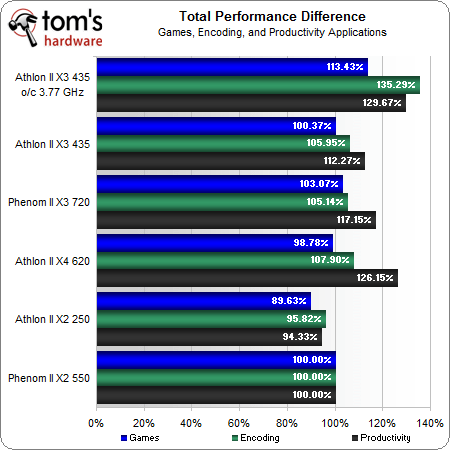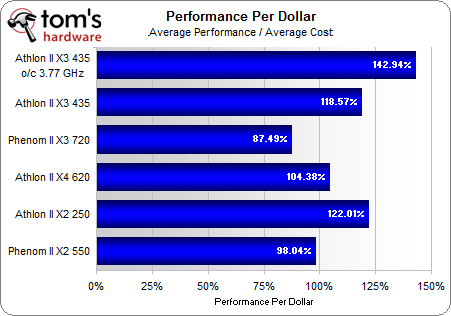Athlon II X3 435: AMD's Three-Core, 2.9 GHz, $87 Triple-Threat
Today AMD introduces what might turn out to be the ideal budget CPU, with three cores for multi-threading, a relatively high 2.9 GHz clock speed, and an impressive sub-$90 price tag. How does it stand up to the rest of the company's Athlon and Phenom IIs?
Conclusion
Let's look at all the results, diluted into one simple chart:
Here's where it all comes together. Look at the Athlon II X3 435 versus the Phenom II X3 720. For three-quarters of the price, the Athlon II X3 435 offers identical encoding ability, less than a three percent disadvantage in gaming, and less than a five percent disadvantage in productivity metrics.
Now let's look at performance per dollar for all of these CPUs, based on existing Newegg pricing for the available units and $87 MSRP pricing for the upcoming Athlon II X3 435:
Here is where the Athlon II X3 435 really shines. Yes, the Athlon II X2 250 has a marginally better price/performance ratio, but remember that multitasking will cripple the Athlon II 250, while the Athlon II X3 435 will fare much better with its extra CPU core. In addition, the Athlon II X3 435 beats the Athlon II X2 250 by about ten percent across the board--a significant performance increase. Compare this to the Phenom II X3 720, which costs one-third more to deliver essentially the same performance as the Athlon II X3 435.
Yes, the Phenom II X3 720 has an unlocked CPU multiplier, and that's worth something. But if you have a high multiplier to work with, like the Athlon II X3 435 does, you can achieve overclocking results equally impressive. It takes a little more effort, and in the case of our test sample, it didn't take much effort at all.
In the final analysis, this author can recommend AMD's new Athlon II X3 435 as the best budget CPU for the dollar available at stock clock rates. We haven't properly compared all of these CPUs when overclocked, so we'll leave that judgment for a future review. Regardless, the Athlon II X3 435 is a fantastic buy, and obviously offers reasonable headroom to the overclocking fans out there. We can't help but speculate that the Phenom II X3's days are likely numbered with the Athlon II X3 offering comparable performance for a lower price and on a more affordable die for AMD to manufacture.
Aside from that, AMD has introduced a number of low-power CPU options likely to be quite attractive to the power-conscious contingent, and with a maximum draw of 45W, the Athlon II X4 605e presents the lowest demands of any quad-core consumer-level CPU, potentially idea for home theater PC deployments.
Get Tom's Hardware's best news and in-depth reviews, straight to your inbox.
Moving Forward
While AMD is currently able to demonstrate dominance in the sub-$120 CPU market, we have to wonder how long the company has to continue without serious competition from Intel, which has been leaning on derivatives of the older Core 2 architecture thus far. Intel has scheduled the release of its entry-level Core i3 early next year, a processor based on its Nehalem architecture, and it remains to be seen how competitive the Athlon II will be against this new threat.
Having said that, next year is months away (a long time when it comes to PC technology). For now, AMD has an impressive product in the Athlon II X3 435. With low prices, a great deal of selection, and good scalability, these CPUs are sure to score AMD favor with the value crown in the months to come.
Don Woligroski was a former senior hardware editor for Tom's Hardware. He has covered a wide range of PC hardware topics, including CPUs, GPUs, system building, and emerging technologies.
-
ominous prime AMD is really thriving in the budget sector, I wonder how the i3's will affect the market. I hope AMD can get back to head to head with Intel on the high end though.Reply -
rdawise Smart move by AMD by attacking the budget crowd (especially around the holiday season). I am surprised how well this thing did against the X2 550! Seems like a good candidate for a budget gaming/multipurpose build. Any release dates available (for NewEgg)?Reply -
tacoslave this is awesome but (and its a big one) i kinda wanted to see something that pwns intels core i7 in everything. Kind of like what they are doing in the graphics department but total domination. How long will i wait!!!Reply -
lemonade4 http://media.bestofmicro.com/O/H/227681/original/Athlon%20II%20X3%20CPU-Z%20Stock.jpgReply
2 cores 2 threads? -
JonathanDeane 3 cores at almost 3Ghz for this cheap? Hmmm not a huge AMD fan but this is plenty of CPU for most people. I would snap one up if I was building a system right now.Reply -
DokkRokken That's one impressive little chip! Pair this with a 770 chipset and you'd have the basis for a cheap and cheerful gaming PC!Reply -
cleeve lemonade4http://media.bestofmicro.com/O/H/2 0Stock.jpg2 cores 2 threads?Reply
Aha! Thanks for catching that. After I had done the testing I was playing around with disabling CPU cores in the OS, and I forgot to turn them back on to take the screenshot. Fixed!

